These three mistakes in 3-bet pots are sure to cost you a lot of money. Almost everyone makes them, and even high-stakes players often succumb to the last one. So watch until the end for an easy way to increase your win rate.
Too small bets on low textures
When in a low SPR we see a flop like , considering how dry it is, one would want to bet a small c-bet, because it seems that a large sizing will not work so effectively here. However, when we ask the solver, it turns out that it likes to bet a lot, 2/3-3/4 of the pot. The reason is that our range is quite polarized: we have a lot of overpairs and few underpairs, and overpairs want to bet big. The same applies to low paired boards.
Consider an example where the cutoff raises to 2.3bb, the button 3bets to 7.5bb, and the cutoff calls on GGPoker.
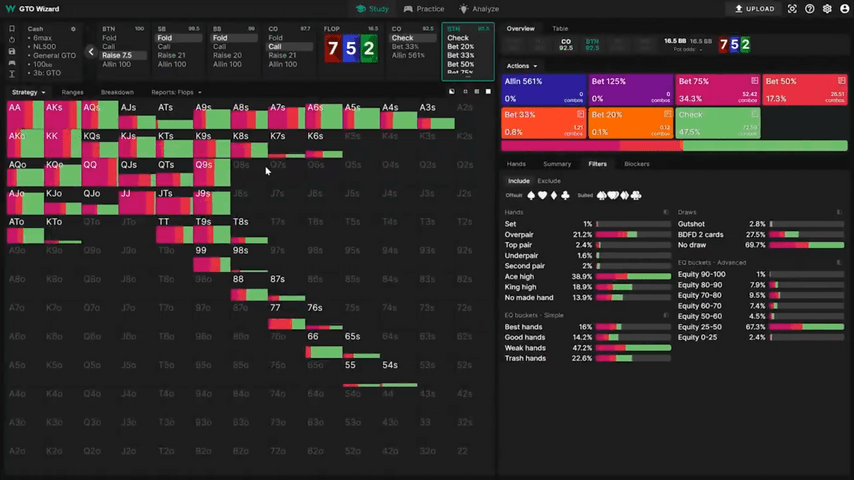
The solver prefers sizing 75% of the pot. Pay attention to the composition of the button's range – he has practically nothing between overpairs and overcards.
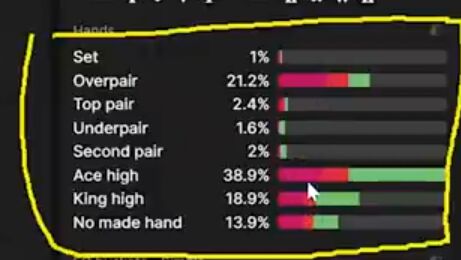
Overpair equity against Villain's range is around 80%, so there's nothing stopping them from betting big. A third pot sizing is usually reserved for hands with 60-65% equity that can't bet big so as not to isolate against strong hands, but this is not a problem here. By betting big, we simply get more value against hands far behind – matches, underpairs, and weak overpairs. For us, this is a great result.
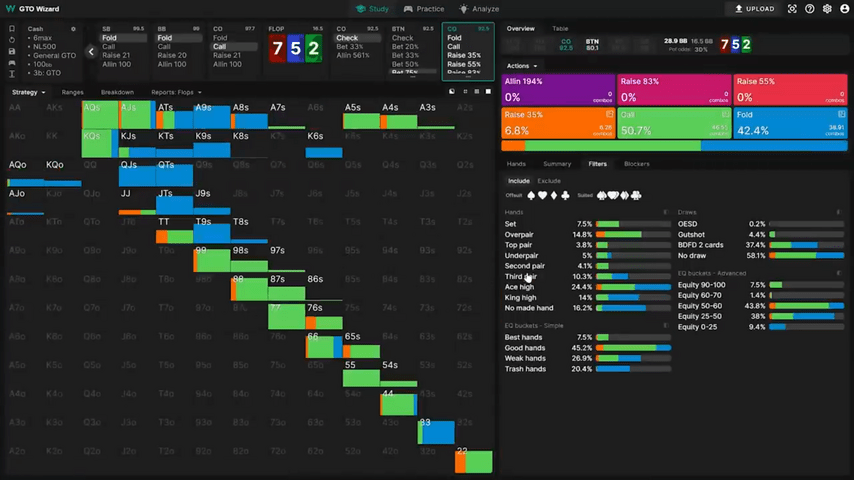 Cut off strategy for a big c-bet
Cut off strategy for a big c-betFlop little different from the flop Our range is also made up of overpairs and overcards. The solver chooses a smaller sizing, but still larger than most of you are used to betting – half the pot, and does so with 73% of the range.
Why doesn't this work in single-raised pots, where we really benefit from using a small sizing? Because players' ranges are wider, and the aggressor's range is not as polarized, he gets top pairs and low pocket pairs, and and become borderline value: by betting a third of the pot with them, we get from all the weaker A-high, as well as and . If we start making pot bets, we will lose this value. The equity of our best A-highs in a 1-raised pot is about 63%, while it is 49% equity in a 3-bet pot.
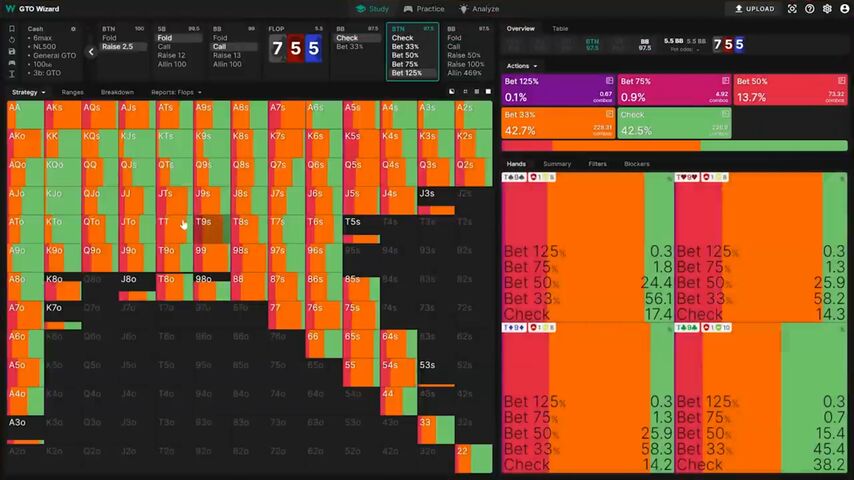
On their own, overpairs would like to bet big, but their share in our range is much smaller than in a 3-bet pot. The sizing is built to cater to more marginal hands. Any need a bet for defense to drop the opponent's , who have a lot of equity – six outs to match plus three sevens.
Now check yourself. On a 752r board in a 3-bet pot, the solver prefers 3/4 pot sizing. What will change on the texture with a possible flush draw?
A) The sizing will decrease: overpairs have less equity
B) The sizing will increase: you need to draw with a flush draw
C) There will be no changes
Correct Answer -
A. Instead of 3/4, the solver moves to half the pot.
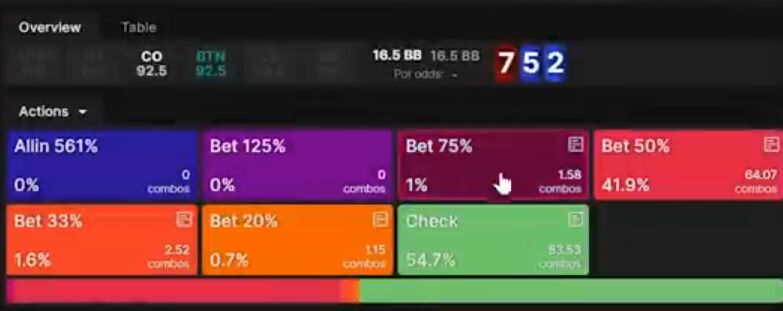
If you look at all textures from 8-high and below, you can see that 3/4 sizing is used only on rainbows. Flush draws play mostly half the pot, with the most coordinated draws (usually 87x) adding quite a few small bets. The fact is that on our big sizing, the solver will stop defending all pocket pairs that have two outs against our overpairs, since it has better candidates – a flush draw. On the rainbow board, pocket pairs have to endure.
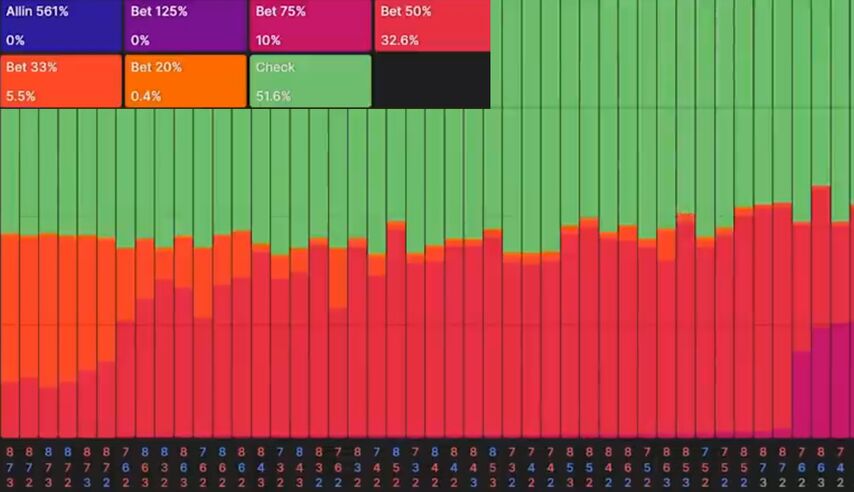
Continuing too often with weak overpairs
We are used to doing this in ordinary pots. It's natural for the button against the big blind to c-bet nines or tens on a low board, and less vulnerable aces or kings can be used to defend a checking range.
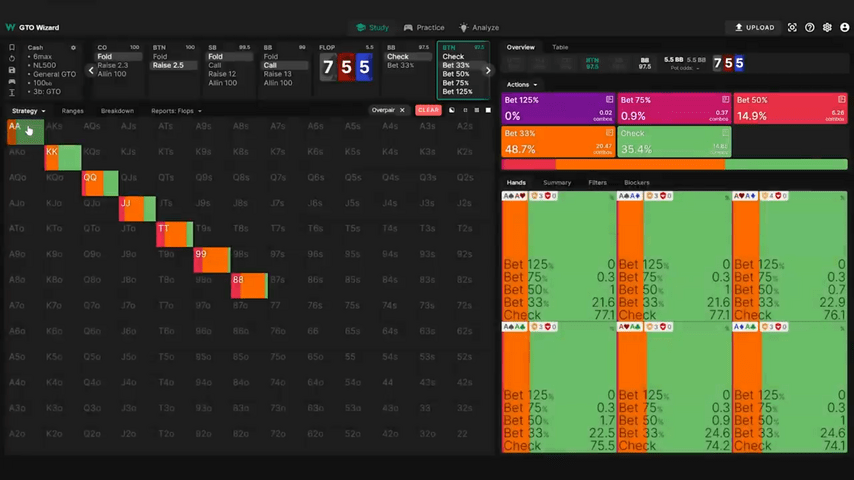 Button vs. BB, single-raised pot. How many checks from AA and KK!
Button vs. BB, single-raised pot. How many checks from AA and KK!Transferring the same logic to 3-bet pots turns out to be a pretty big mistake. The thing is that in an ordinary pot our and differ little in strength, since BB has no pocket pairs better than . But the person who called the 3-bet does have those. Our aces have 84% equity in a 3-bet pot on the 752r board, and only 59% equity for eights. Therefore, the stronger our overpair, the more willingly we should bet with it:
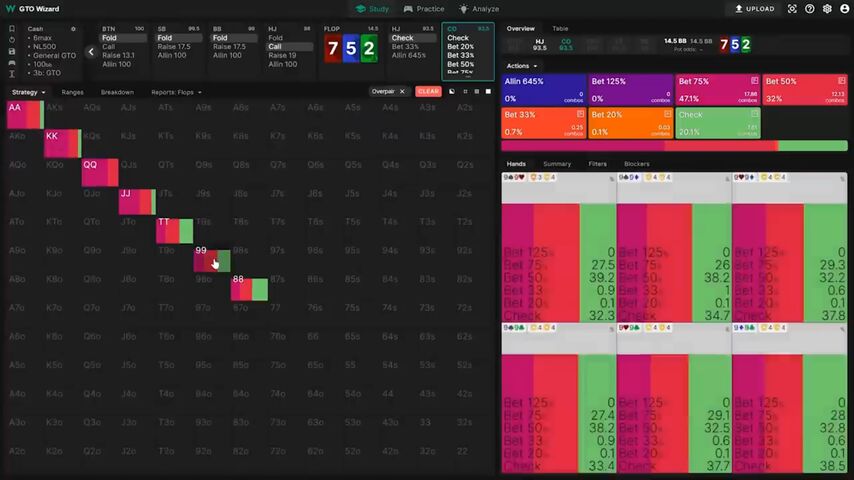
The role of a vulnerable overpair that needs protection in a 3-bet pot passes to . And tens, nines, and eights mix c-bet with rather frequent checks.
How do you exploit an opponent who doesn't see the difference and cbets too often with weak overpairs? I can suggest a more aggressive game with and . (By the way, this is pretty common live.) In a GTO environment, the ladies are indifferent to the choice between check-raising and check-calling, but against an unbalanced opponent, check-raising becomes much more profitable.
Test question. What should be our turn lead strategy (after checking the flop) against an opponent who bets all overpairs on the flop? (Let's say the turn also hits a low card.)
A) Bluffing with all the air
B) Betting bigger and more often with single-pair hands
Correct answer -
Our opponent is capped, his strongest hands are A-high, but capping doesn't necessarily mean overfolding. A 3-bettor is quite capable of overpowering a bet with good A-highs to keep us from easy bluffs. Therefore, we are happy to call with any pairs on board and pocket pairs. And it is not necessary to play with a 20% solver sizing. When the strongest hand in Villain's range is AK, you intuitively want to bet small to make it a guaranteed hit, but the theory doesn't work that way. If our hand is strong enough to bet big, we bet big! Villain still has to call with something, he can't throw away 100% of hands!
Insufficiently turning into bluffs with one pair hands
3-bets in position are strong and linear, so even against small c-bets a player out of position calls very tight. Because of this, many hands from the three bettor no longer have showdown value on the turn. Let's take a 3-bet hijack against UTG, the board rainbow, turn , bringing a flush draw. On the flop, the hijack c-bets 20% of the pot, to which UTG immediately folds almost all pocket pairs from and below. Therefore, on the turn a 3-bettor has almost no showdown value – this hand (without a flush draw) has only 31% equity. Bluff with as often as with gutshots and .
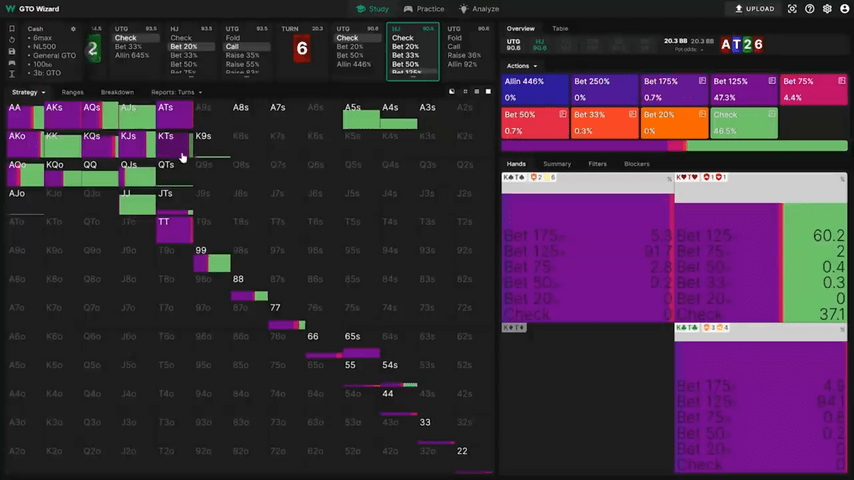
Second barrel with forces the opponent to fold all remaining combinations and , part of the weak , as well as most of their own . To some extent, this is even a value bluff, because we not only knock out hands stronger, but also receive calls from a part weaker. However, it is not uncommon for even strong players to see a pair and start checking.
Turning second pair into a bluff works on boards with a gap between the highest and second highest flop cards – , . But on the texture , for example, bluff with . The solver doesn't like it on the turn: this hand does have showdown value. The same applies to on the board .
Let's get back to the flop now . When we do a frequency c-bet with , the opponent folds a small part and , that is, our eights partially become a bluff already from the flop. As you can imagine, we have every right to keep bluffing them on many turns! Let's say on the turn our eights and nines is a 100% second barrel 3/4 pot, allowing you to knock out everything and many and , but get called by and who caught a straight draw.
Considering that even very strong players often under-bluff with pocket pockets and second pair, the best exploit against the field would be to double-barrel all bluff catchers that, in the GTO world, are indifferent to the choice between calling and folding. This strength of the field will also influence our choice of bluff catchers. Say on the board the reason why about half callers tolerate the second barrel is due to their good equity against . Against standard opponents, queens can safely fold.
General conclusions:
– the value of the overpair in a 3-bet pot matters – the higher it is, the more often we should bet;
– increase sizing on dry low boards – up to 3/4 pot;
– When ranges get tighter, the line between value and bluffs blurs, and we often have to bluff hands that we think have showdown value.


